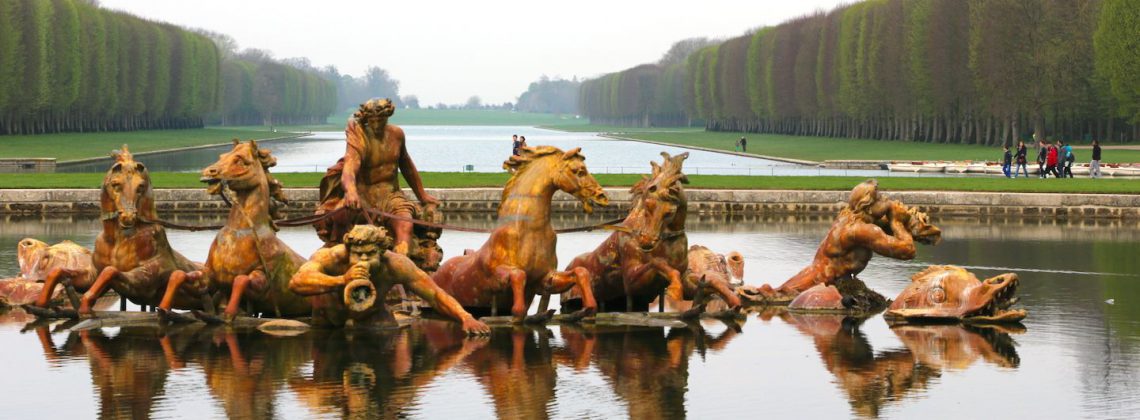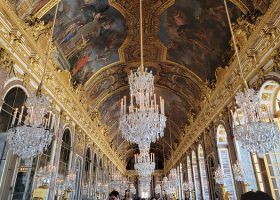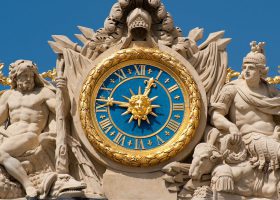Versailles is a must-see if you’re in Paris. The history? Wild. The opulence? Over-the-top. But let’s be real, it’s not just about gawking at gold and marble—there’s some serious drama behind those walls. You can’t truly understand France without taking in Versailles, but don’t get too caught up in the fairy tale. The place is as much a symbol of decadence as it is a reminder of how that kind of excess all came crashing down. Here’s everything you need to see in Versailles.
Pro Tip: Planning what to do on your trip to Versailles Palace? Bookmark this post in your browser so you can easily find it when you’re in the city. Check out our guide to Versailles for more planning resources, our top Versailles tours for a memorable trip, and the if a Versailles tour is worth it.
Must-Sees at the Palace of Versailles and Gardens
If you’d told anyone back in the mid-1600s that some old hunting lodge, 22 miles outside Paris, would eventually become the royal palace of France—well, they’d probably think you were crazy. Fast forward, and thanks to King Louis XIV, Versailles isn’t just a palace, it’s a historical juggernaut. It’s a symbol of excess, power, and grandeur that’s cemented its place as one of the top spots to visit in France.
But here’s the thing—there’s a lot to take in. The palace has 2,300 rooms, so don’t even try to see them all. And don’t sleep on the gardens—they’re massive and just as iconic as the palace itself. But don’t worry, I’ve got your back. To help you make sense of the overwhelming splendor, I’ve mapped out the absolute must-see spots at Versailles so you can make the most of your visit without getting lost in the maze of gold and mirrors.
1. The Hall of Mirrors
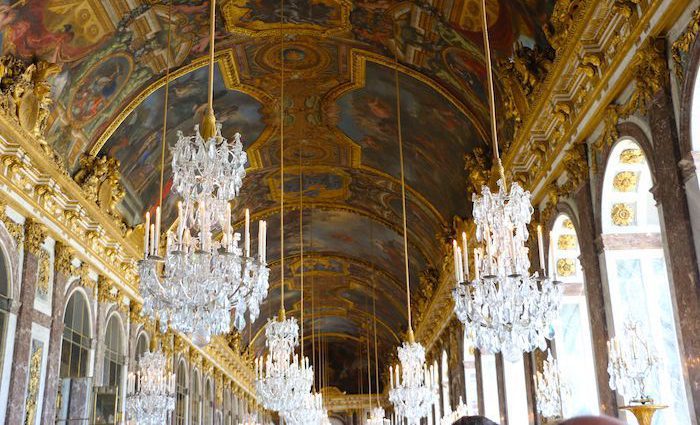
The Hall of Mirrors is the room at Versailles—the one everyone talks about, and for good reason. With 357 mirrors reflecting chandeliers and natural light from the garden windows, it’s a feast for the eyes. But it’s not just about the bling; this place is dripping with history, like the Treaty of Versailles being signed here in 1919 to end World War I.
Originally a terrace with a view of the gardens, this space was transformed in 1648 by Jules Hardouin-Mansart from a drafty afterthought into a room fit for a king—literally. Now it’s one of the most visited spots in the world, and trust me, you’ll want to see it for yourself.
Not ready to book a tour? Find out if a Versailles tour is worth it.
2. The Gardens of Versailles
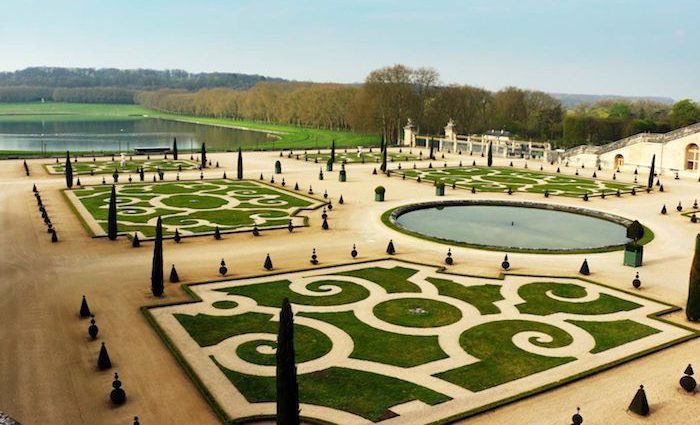
Deciding which deserves the top two spots at Versailles is tough, but here we are. The gardens? Massive, grand, and impossible to truly capture in words—but I’ll give it a shot.
Built over 40 years by thousands of workers, these gardens are so huge they get replanted every 100 years to keep them looking fresh. The last refresh was in the early 2000s, so if you visit now, you’re seeing them pretty much as they were in Louis XIV’s time.
Not ready to book a tour? Find out if a Versailles tour is worth it.
What to see in the Gardens of Versailles:
The Four Season’s Fountain: As you walk down the Royal Way, you will notice that there are alleys running parallel and perpendicular to this road. At the crossroads, you will find the Four fountains.
Neptune Fountain: The Neptune fountain is one of the biggest fountains with 99 jets that spout water. Its name comes from the towering statue of Neptune overlooking the sea creatures.
Latona’s fountain: This is one of my favorite and also is huge! Inspired by The Metamorphoses by Ovid, it portrays the goddess Latona protecting her two children, Apollo and Diana, who were being insulted by peasants from Lycia. Her rage forced Jupiter to turn all the residents into frogs. If you look closely you will notice frogs sculpted on the lawn around the sculptural group.
Walk the paths: The gardens are actually free to enter during the week if you don’t want to enter the palace, except on Tuesdays and the weekend, where you will need to pay for the fountain show.
Rent a bike or golf cart and explore: You have two spots where you can rent a bike: one at the beginning of the gardens and one below towards the grand staircase. You can also find golf carts here if you prefer a more leisurely drive through the grounds. Go for it!
Our Best Versailles and Paris Louvre Tours
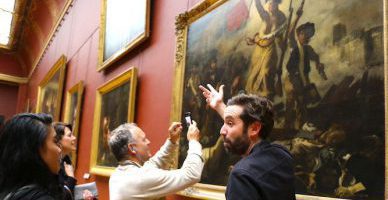
Top-Rated Tour
Secrets of the Louvre Museum Tour with Mona Lisa
The Louvre is the largest art museum on Earth and the crowning jewel of Paris, which is why it’s on everyone’s bucket list. Don’t miss out on an incredible opportunity! Join a passionate guide for a tour of the most famous artwork at the Louvre. Skip-the-line admissions included.
See Prices
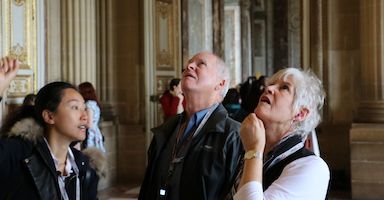
Likely to Sell Out
Ultimate Palace of Versailles Tour from Paris
Versailles isn’t that difficult to get to by train, but why stress over the logistics? Meet a local guide in central Paris who will purchase your train tickets and ensure you get off at the right stop. Then enjoy a guided tour of the palace and the unforgettable gardens. Skip-the-line admissions included to the palace and gardens.
See Prices
3. The Gallery of Battles
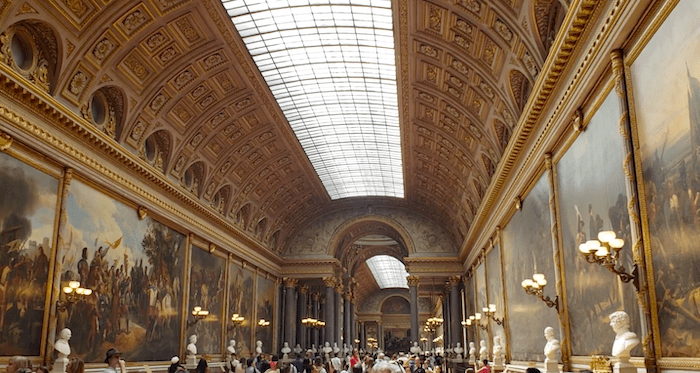
The Gallery of Battles is one of Versailles’ most impressive spots. Created by Louis-Philippe I to honor France’s military history, the walls are lined with massive paintings that pack a serious patriotic punch.
The sheer scale and drama of these works make it the perfect place to soak in the talent behind some of France’s most iconic historical moments.
4. Place d’Armes & The Gate of Honour
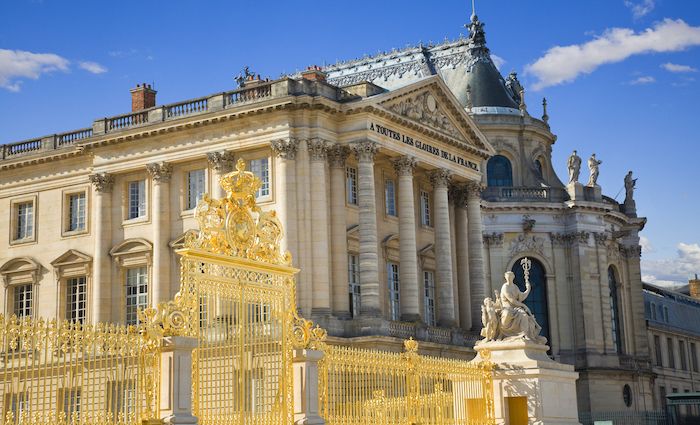
Lucky for you, you really can’t miss this part if you’re visiting the Versailles Palace. Place d’Armes is the massive funnel-shaped courtyard that sits in front of the palace. It is the site where three streets converge: Avenue de Saint-Cloud, Avenue de Paris, and Avenue de Sceaux.
The gates are not original to the Palace (gasp!). Those were torn down during the French Revolution and were replaced in 2008 in a massive project. The gate is 80 meters long and made from steel coated with 100,000 gold leaves. It’s fitting that the first thing you see in Versailles defines the palace as the opulent estate it truly is.
Not ready to book a tour? Find out if a Versailles tour is worth it.
5. The Empire Rooms
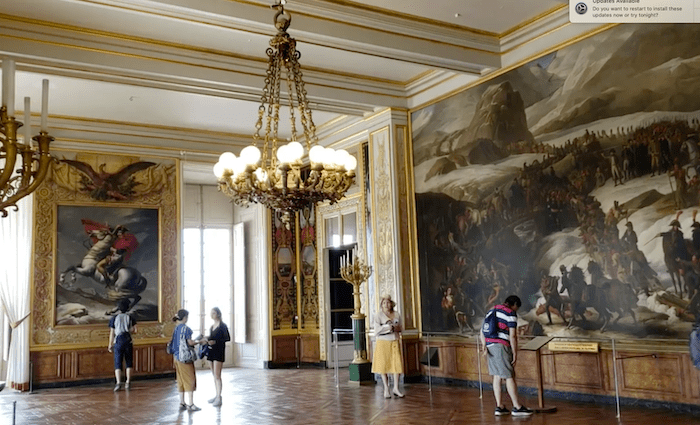
These rooms were also created by Louis-Philippe, a contemporary of Napoleon, in an attempt to gain the support of Bonapartists and former members of the empire. He collected many of the largest paintings commissioned by Napoleon in the palace’s south wing, where you can find them today underneath the Gallery of Battles.
6. The Queen’s Hamlet
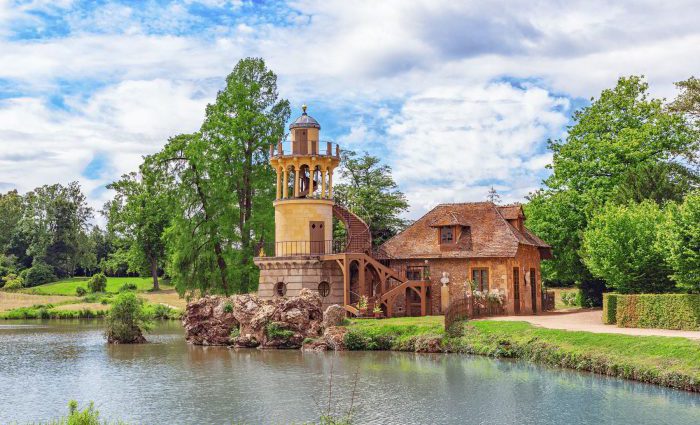
Out of everything that you will see at Versailles, nothing will really prepare you for the Queen’s Hamlet. When you think of Versailles, the first words that come to you are probably “extravagance and lavishness”. It’s a common belief based on reality.
So it may come as a surprise that, at first glance, the Queen’s Hamlet would seem to contradict that entirely—until you understand that this Hamlet was commissioned by Marie Antoinette solely for her to experience what it was like to live in a peasant hamlet. Enough said.
The queen would take relaxing walks here and imagine she was a commoner, although naturally, she would never actually work like a commoner. When many were starving in poverty in Paris, a popular saying to underscore Marie Antoinette’s lavish life was “Let them eat cake.”
During the French Revolution, the Queen’s Hamlet fell into disrepair. Napoleon later restored most of the area and gave it as a gift to his wife Marie Louise. This was a bit ironic and also symbolic since she was the grand-niece of Marie Antoinette!
The hamlet is defined by five features you should see:
- The Windmill: Never used to grind grain, but just to have the look of a farm.
- Marlborough Tower and Working Dairy: A functioning dairy farm where they could enjoy cream and cheese.
- The Guard House and Dovecote: The house of the Queen’s guard and also where they grew hens and pigeons.
- The Boudoir: A small house to host guests and to eat.
- The Queen’s House and the Stove Room: A house solely for the Queen where she could host guests or have a rest.
7. Petit Trianon
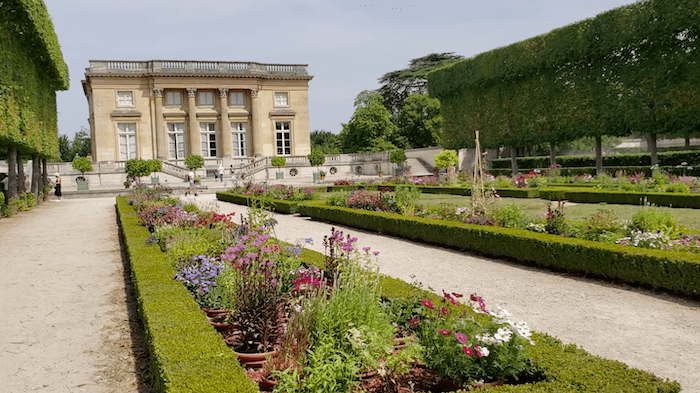
In 1758, Louis XV decided there still weren’t enough palaces on the Versailles estate and began constructing another one. This one intended to be big enough to house the king and his royal entourage.
To differentiate between the Grand Trianon built by his great-grandfather Louis XIV, he was to call this the Petit Trianon. The in vogue architectural style at the time was neoclassical and the royal architect Ange-Jacques Gabriel did not disappoint in building the perfect example.
Unfortunately in April 1774, King Louis XV felt his first symptoms of smallpox at his new residence and died only a few days later. This pushed his son Louis XVI into the limelight, and he decided to give the Petit Trianon to his young bride Marie Antoinette as a gift. She immediately redecorated the palace and even changed the botanical gardens that were set up by Louis XV into an Anglo-Oriental garden which was the “in thing” at the time.
During the French Revolution, the Petit Trianon was turned into a housing area for those of few means. Napoleon later brought it back to life and had the entire area restored. He gave it as a gift to his wife and subsequently to his second wife Empress Marie Louise. Ironically, in 1867 the Petit Trianon was converted into a museum by the wife of Napoleon III and dedicated to Marie Antoinette.
8. Grand Trianon
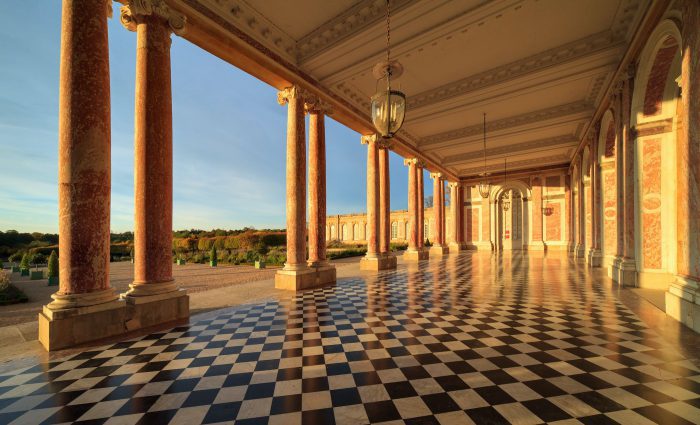
The Palace of Versailles was so extra, Louis XIV couldn’t even take the chaos of his own court. So, what does he do? Builds himself a whole other palace to escape it all—and, let’s be real, to have a private spot for his mistress, Madame de Montespan. Because why not?
Enter the Grand Trianon, a little jewel of a palace tucked away from the madness. Architect Jules Hardouin-Mansart called it “A little palace of pink marble and porphyry, with marvelous gardens.” Louis XIV had very specific ideas about what he wanted, and Mansart didn’t have much room to wiggle—Louis was constantly checking in on the construction. Yeah, talk about a micromanager.
But if you thought Versailles was over the top, the Grand Trianon takes it to the next level. The flower displays alone are a flex. We’re talking massive flowerbeds and terraces filled with thousands of individual pots, all meticulously swapped out every day. Think about that for a second—changing flowers every damn day. That’s not luxury; that’s excess with a capital E.
This place didn’t just get left to gather dust. After Louis’ time, King Stanislaw I of Poland hung out here when he visited Versailles, and Napoleon used it as a getaway spot, too. Fast forward to 1963, and General De Gaulle gives the palace a makeover, turning it into a spot for hosting foreign dignitaries and using it as his own presidential retreat. Because, why not, right? A little history lesson and a serious flex in one.
Not ready to book a tour? Check out our Versailles Guide for more resources.
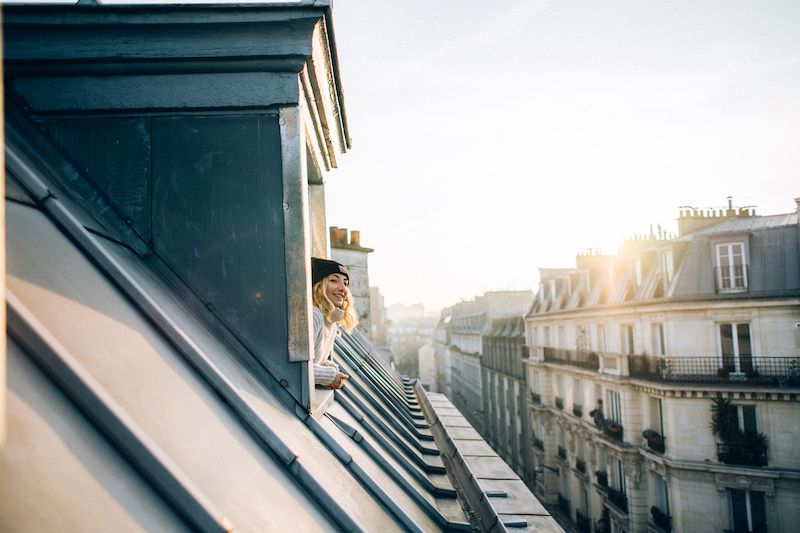
Where To Stay in Paris
With a city as magnificent as Paris, it can be hard to find the perfect hotel at the perfect price. Explore the best hotels and places to stay in these incredible neighborhoods in Paris.
